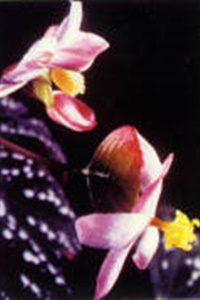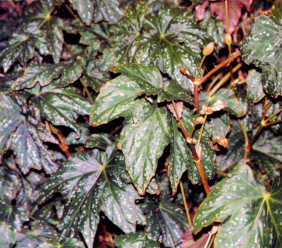I was taken aback; not just because someone would munch on a show plant, but also because that plant might have been sprayed with pesticides. Charles later laughed about it, and assured me that he never, ever used toxic chemicals on his babies. The taster would not keel over.
Begonias are edible, a fact that appalls some of us and appeals to others. Whether you want to munch on it or not, there are good reasons to grow B. deliciosa. It’s a treat for the eyes, too.
B. deliciosa is a charming begonia, with cleft dark leaves generously spotted with silver; its delicate light pink flowers are fragrant. Classified horticulturally as “rhizomatous, rhizome erect, jointed at or below soil level,” it produces odd bulbous growths at soil level, then shoots stems straight up into the air. It can grow to a medium-sized shrub.
B. deliciosa was discovered by Jean Linden in 1881 in Borneo, a land of steamy climate. It is beautifully suited to its home with Charles in Florida. In less tropical areas it will require winter protection, and additional humidity will help. Place it near a water source, don’t let the soil dry out, and do all you can to keep the humidity high.
Charles Jaros has another link to this begonia. In 1976 Paul Lowe crossed B. hatacoa ‘Silver’ x B. deliciosa, and produced B. ‘Charles Jaros’ ABS registration #812.
Some of our top hybridizers have used this Borneo native: Belva Kusler created B. ‘Jean Heff’ (B. deliciosa x B. kenworthyae; ABS registration #368, 1973); Michael,Kartaz created B. ‘Tsunami’ (from the same cross as Lowe, 1978). In Japan Isamu Misono crossed B. masoniana x B. deliciosa to create B. ‘Bronze Iron’ (1980). All of these offspring were classified as “rhizomatous, rhizome erect” or as “rhizomatous, rhizome jointed at or below soil level with erect stems.”
Crossed with rexes, B. deliciosa produced rex offspring. Kit Jeans Mounger crossed B. ‘Hallelujah’ (one of her hybrids, an upright-stemmed rex) x B. deliciosa and got B.’Camisole.’ Robert Cole crossed B. deliciosa x ‘Sir Roy Yewell’ for B. ‘Satire’, a rex with an upright stem and large spiral leaves.
Then, the always adventurous Patrick Worley crossed thick-stemmed, hairy leaved B. dipetala x B. deliciosa. Resulting seed produced four begonias distinctive enough to name: B. ‘Daniel Worley’ ‘Jesse Worley’, ‘Ricky Kramer’, and ‘Shawne Worley’. Neither thick-stemmed nor rhizomatous, all these are classified as shrub-like, distinctive foliage, unusual surface and/or coloring, and described as everblooming with pink flowers.
ABS sponsors an ‘Adopt a Species’ program through the Conservation Department. If you would like to ‘adopt’ a species, grow, propagate, report on it, and share it with others, contact:
Tamsin Boardman,
Conservation Chair,
PO. Box 69
Bluff Dale, 7X 76433



